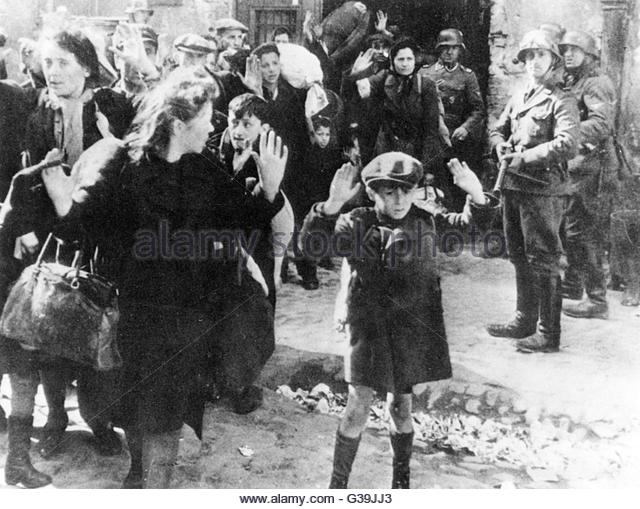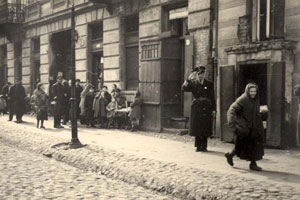PHOTOGRAPHING THE WARSAW GHETTO: ALBUM OF A GERMAN SOLDIER
by Yad Vashem

While the ghetto’s Jewish leadership decided to immortalize its positive activities in pictures, the Germans used their cameras to document the harsh reality of life in the ghetto. In addition to the official photographers who came to the ghetto to shoot news and propaganda photos, there was also a widespread phenomenon of “soldier tourists” in the ghetto. The Warsaw region encompassed a large number of German military bases and the city also served as an important crossroads for military transportation on the Eastern Front. Many soldiers passed through the city and spent their free time there. The Jewish ghetto, following its closure in November 1940, quickly became an anthropological attraction for these soldiers. We know of at least ten collections of photos in varying sizes that were taken by soldiers in the ghetto during their off hours. Over time, some of the pictures taken by soldiers have become “standard” photos of the ghetto, which is what happened to the more than 150 photos taken by the soldier Heinz Jost in the ghetto over the course of several days in 1941.

The photographs shown here were taken by a soldier who served in a supply unit for the German Air Force in the Warsaw region. They were arranged by him, together with other photos of Warsaw and his army experiences, in a fine, leather-bound album that read, “Das Warschauer Ghetto. Ein Kulturdokument für Adolf Hitler” (The Warsaw Ghetto. A cultural document for Adolf Hitler). Of the 109 photos contained in the album, 56 of them deal with the ghetto. Some of these pictures were taken from a car, and we assume that the soldier came to the ghetto on a cold but sunny day, with someone else in the vehicle, exited the car somewhere in the ghetto and wandered around on foot. Unfortunately we do not know the exact date on which the photos were taken, but we can guess it was in 1942. All of the photos were taken outdoors and they depict all of the things that the Judenrat’s pictures did not: the suffering and difficult conditions in the ghetto. In many photos we see people who have collapsed in the street, children begging and the general misery that shrouded the streets of the ghetto. Nevertheless, the photos also show the people’s efforts at maintaining a normal way of life under these difficult circumstances, and their attempts to engage in commerce and trade. Particularly notable are the two extremes of commercial life in the ghetto: on the one hand there are depressing stores that have managed, somehow, to remain in business; on the other hand, we see the active street trading that characterized the ghetto streets.
In contrast with official photographs taken by Jewish organizations, in which it would seem that the subjects were asked to ignore the camera, in the soldier’s photos we can sense the subjects’ awareness of the camera’s presence. People stood facing the soldier’s camera, and smiled for him. In one of the pictures (15) we even see a Jewish policeman saluting the photographer. Evidently, at this stage the ghetto residents had a ready response when a photographer appeared in their midst – a further indicator of the large number of photographers who came to the Warsaw ghetto.
EDITOR'S NOTE: Most of the photographers were Germans and Nazis and/or Nazi sympathizers. Kathryn Berman of Yad Vashem (quoted February 12, 2017 by Lawrence Bush in Jewish Currents here) wrote:
Joe J. Heydecker, a soldier in the Nazi army who preserved forty-two photographs that he made inside the Warsaw Ghetto in early 1941, was born in Nuremberg on this date in 1916. Heydecker was a journalist and photographer who was ordered into Warsaw to join a propaganda unit. Anti-Nazi in sentiment, he secretly took hundreds of photos in spite of a 1941 Nazi prohibition against independent photographers. With the help of two friends in his military unit and his wife, he kept the film safe and secure even when the Gestapo raided his home. Eventually, his images were used as evidence in the Nuremberg trials (he was one of the few German journalists to report on those trials). After the war, Heydecker spoke on German radio about the horrors he had witnessed. He moved to Brazil, where his photos were shown to the public for the first time as part of a 1981 gallery exhibit and a book. “I find it hard to explain why nearly forty years have passed before I was able to publish these pictures,” he wrote. “I believe I simply had not strength enough to write the text, although I tried several times. . . . Now I do what I can to set down what is seared into my memory, weak as it may be, because time is running out.” Heydecker died at 81 in Vienna in 1997.
“[I]n 1937 he had spent a year travelling with his parents all over Poland, especially in Galicia and Volhynia, where they were welcomed as guests of Jewish families. His parents worked in the film industry. Heydecker had broken off his work as an apprentice photographer in order to travel with his parents, who had previously spent time outside Germany, feeling uncomfortable with the political situation. Heydecker quotes his father as having said, ‘In such a country as this I will not live.’ . . . During the year Heydecker spent in Poland, he spent much time in Warsaw and states that he was ‘able to move about in a world that was then still free, to read books, journals and papers and assimilate information that would have been impossible inside Germany after 1933. I saw Nazi Germany as it really was. This not only immunized me to its temptations, I opposed it.'”
This quote is taken from a review written by Kathryn Berman of
Joe J. Heydecker's book entitled, "Where is thy brother Abel?
Documentary Photographs of the Warsaw Ghetto." The review is
archived at
http://www.yadvashem.org/yv/en/education/books/brother_abel.asp#!prettyPhoto
This article is from Yad Vashem: The World Holocaust Remembrance
Center. It is archived at
https://www.yadvashem.org/yv/en/exhibitions/warsaw_ghetto/german_soldier.asp.
Google has a large collection of prints. Scroll down here. Click below these photos for many more images.